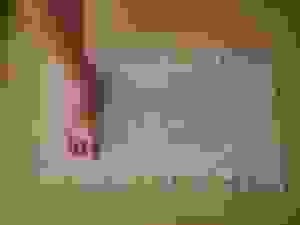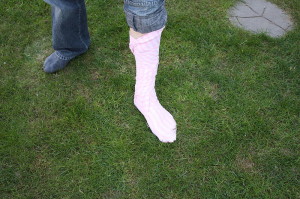Russia: Riddle, wrapped in a mystery, inside an enigma. So said Winston Churchill, when attempting to describe this massive swathe of baffling land, and rich, but historically obscured culture. And there’s no greater mystery in all of Russia that I can possibly think of than the issue of why the Russian military didn’t use socks until 2013.

That’s right. No socks. What did they have instead? Portyanki. A 400 year old tradition that proves tradition isn’t always right. Sometimes, it’s just downright silly.
What the heck are portyanki?
They’re cloth footwraps. Instead of socks, Russian soldiers (as well as others throughout Eastern Europe) wrapped strips of cloth around their feet in specific patterns to cover the entire foot, before strapping on the boots and going into battle.
And I’m too lazy to tie my shoes. I’d go insane if I had to tie my socks too.
Check it out:
Why would anybody use portyanki instead of socks?!?
Now don’t get all up in arms about how ridiculously backward this practice seems; first of all, footwraps were in widespread use all over the world, long before socks were developed or became cheaply available. In many cases, it was simply the only option. And even after socks were invented, it was a long time before they became cheap enough for anyone but the higher-ranking officers to use them. Even fancy shmancy Finland was still using them in the 1990s.
But the footwraps had a number of other advantages as well; first of all, you can scrounge them from anywhere, from an old t-shirt or a ripped up pillowcase. They also dry faster than socks, since they unfold into a single thin layer. Repairs were fairly easy, though you could just ignore small holes, since wrapping the cloth around the feet results in multiple layers anyway, so a hole in a single layer isn’t a big deal.
In other words, they’re exactly the kind of gear you’d expect to see in a scrappy fighting force of quickly conscripted soldiers who didn’t have access to a budget surplus.
So…Russia.
So why switch to socks?
Well, socks are better. If you can afford socks, you wear socks.

Portyanki need to be tied correctly, since any fold or lump in the fabric will quickly form a serious blister. Plus, socks are a whole lot faster to deal with. Not only in use, but in training as well. You don’t have to train soldiers on how to put on a sock. Their moms did that for them already.
But damn, it took a long time. Partial changes began in 2007, with portyanki scheduled to be completely phased out by 2013. If there’s anything that represents Russia’s slow, laborious inability to shed outdated technology, this has got to be it. Even Ukraine and Belarus beat them by abandoning portyanki a few years earlier.
But…portyanki will be missed…sort of?
Despite the fact that socks are a billion times better, plenty of Eastern European soldiers remained rather nostalgic about their high-maintenance footwear. Word has it that some Ukrainian soldiers even held a farewell ceremony, and songs were written about…little strips of cloth. Weird, right?
I suppose it’s just a matter of growing up with something, and finding it hard to let it go. It was a ritual, and in some ways a hassle, but it’s a hassle people got used to, and probably had a lot of memories that came with them. They lived with them, and now they’ll be gone forever.
I bet a few of those soldiers will break out the portyanki one day, many years from now, and give their feet one last good wrapping, and shed a tear for days gone by. And it’ll be adorable.
Weird, but adorable.




Wow! I’ve never heard of this before. I like how you tried to come up with some positives! I think I’ll take longer-drying socks over portyanki any day!
Yeah, “tried” was definitely the operative word there. Socks for me too. But I can see them being useful. In the 1800s or so.
Lol :D
I already get crazy when the seam of my socks gets between my toes. Can’t imagine a portyanki that isn’t folded right!
Me too. Even one single fold would ruin my whole day.
Yup. Never heard of this before. Interesting to see both sides of it though, practical and impractical. I choose socks.
Sorry about commenting on a year-old post, but this is simply outrageous!
Portyanki are WAY better than any sock! Don’t believe me? Okay, let see:
1- You can make it thinner or bulkier just by wrapping it differently, to suit your needs.
2- They are slipper and prevent injury from friction of the footwear.
3- You can use it to make a bandage, bandana, tourniquet, handkerchief, etc…You can even strangle somebody with it.
4- You can make it from almost anything.
5- They have various layers, so you can keep using them even if they have holes…And just wrapping it differently will get rid of any visible holes.
6- They dry easier.
7- They keep your feet warmer.
8- They help to get rid of any undesirable wiggle room in your footwear.
9-They DON’T get between your toes and cause inconvenience, like socks.
10- They’re WAY less itchy than socks.
I could continue this list for hours, but I already made my point.
I myself use my portyanki under my socks (if I use only the portyanki, my superiors get mad at me…Thanks for making us change to socks, western peer pressure)!
Oh, and one more thing: If you take more than 10 seconds to put it on after 1 hour of training, you DESERVE to be K.I.A. in the first 10 minutes of battle!
Those are definitely some good points. Maybe one of these days I’ll try some…
SKYRIM FOOTRAPS ARE REALL
I’ve never seen anything ever written about these. When I first went to Russia (Far East) on a rafting trip in 1992 our guides all wore these. Of course us stupid ignorant Amercanskis thought it was because these “soviet socialists” were too poor to afford socks. I until now never fully understood their purpose and usefulness, thank you Igor Sokolov!! I should never have doubted Russian ingenuity and practicality, far superior. Yes, I should be shot for being so ignorant.
Yeah, they’re pretty neat. Not necessarily all that great, but they have pros and cons that have made them useful, though nowadays with socks being ridiculously cheap, they’re probably not worth it anymore.
Whomever wrote this is an ignorant, bootless,loafer wearing pussy..portyanki dry faster,get a hole you can adjust them to cover,get poorly fitting boots you can build them up in a hollow area that might rub. .you can make them out of anything
They didnt wear them for over 500 years because they were ADORABLE. .they conquered the huns,Napoleon, the mongols, hitler and many others because of this versatile ,effective and traditional foot wrapping. ..the guy is an asshole no nothing
People are really passionate about these things.
I’d say the biggest plus to them is their ease of care: all are one size so they used to just boil them in giant batches, now they need to sort by size. They were also more practical with the types of boots used by the Russian army. Another plus is that unlike socks they don’t move around on your foot so they won’t slide down into the boot as you march or rub against it, socks give you blisters if not fitted. And think about the holes we get in our socks. Now imagine you are on campaign, no new socks in the foreseeable future and you get a hole in one of your’s. Darning it will give you lumps. Portyanki were just more practical. Now in civilian life socks are much better because we can get new ones whenever we need and they do work much better with lace-up shoes.
You’re making want to try this at home.
Western Europe used them too including the Wehrmacht, they are far superior to socks, this coming from an American who just decided to try it out. If you wear jackboots these are necessary or else your heel will flop around, footwraps solves this, they’re more comfortable too in general, and more hygenic.
Used them back in the days in USSR. If you have properly fitted boots you are golden. Better than any sock especially over time. Use them now in the winter months here in North cali.
I’m thinking I might get some scrap wool in a square shape and give this a try…
I first heard of these when reading “One Day in the Life of Ivan Denisovich” in high school. It makes sense people would use these, as sock knitting is more complicated than weaving uniform pieces of cloth.